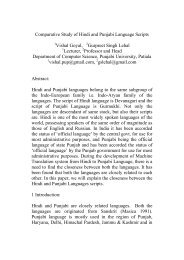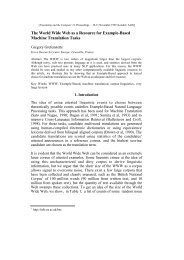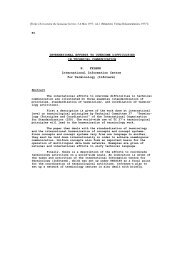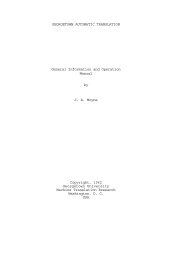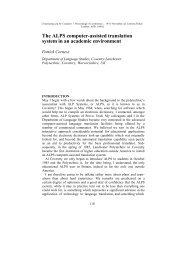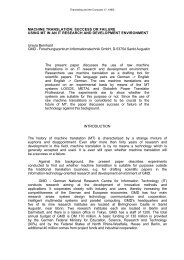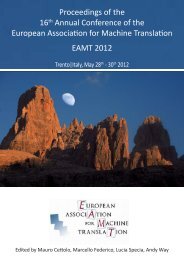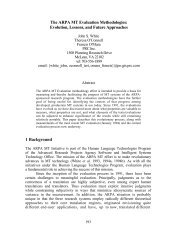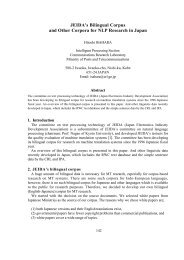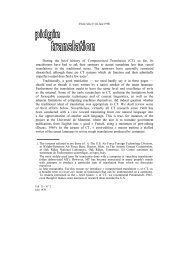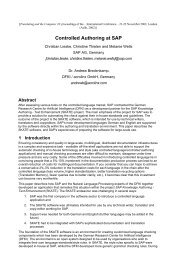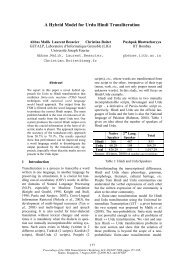The KIT lecture corpus for speech translation - Machine Translation ...
The KIT lecture corpus for speech translation - Machine Translation ...
The KIT lecture corpus for speech translation - Machine Translation ...
You also want an ePaper? Increase the reach of your titles
YUMPU automatically turns print PDFs into web optimized ePapers that Google loves.
on large amounts of in-domain training data (Federico et<br />
al., 2011) (Lamel et al., 2011) (Boudahmane et al., 2011).<br />
<strong>The</strong>re<strong>for</strong>e, in order to tailor our simultaneous <strong>speech</strong> <strong>translation</strong><br />
system to <strong>KIT</strong> wide <strong>lecture</strong>s, we started a comprehensive<br />
data collection ef<strong>for</strong>t <strong>for</strong> <strong>lecture</strong>s at <strong>KIT</strong>.<br />
2. Data Needs of Spoken Language<br />
<strong>Translation</strong> Systems <strong>for</strong> Lectures<br />
Academic <strong>lecture</strong>s and conference talks have only recently<br />
become the interest of research projects and evaluations,<br />
such as the IWSLT evaluation campaign (Paul et al., 2010)<br />
(Federico et al., 2011) or the <strong>lecture</strong> <strong>translation</strong> project at<br />
<strong>KIT</strong>. As discussed above, here, SLT systems can service a<br />
need that cannot be fulfilled by human translators. While<br />
the quality of SLT systems still lacks that of human translators,<br />
their per<strong>for</strong>mance has increased over the years, and<br />
they start to be of value to users now (Hamon et al., 2007).<br />
In order to develop SLT systems that per<strong>for</strong>m well <strong>for</strong> the<br />
task of translating German <strong>KIT</strong> <strong>lecture</strong>s, new data resources<br />
are needed that are not available so far.<br />
While the concentration on <strong>lecture</strong>s already limits the domain<br />
of the SLT system somewhat, the topics encountered<br />
in the <strong>lecture</strong>s can still be arbitrary and thus, the domain<br />
of <strong>lecture</strong>s can still be seen as practically unlimited. Data<br />
resources made available <strong>for</strong> the <strong>speech</strong> <strong>translation</strong> systems<br />
there<strong>for</strong>e need to capture this diversity in order to be able<br />
to train appropriate models, and, even more important, to<br />
reliably assess the quality of the systems developed.<br />
As <strong>for</strong> all learning systems that use statistical models,<br />
<strong>speech</strong> <strong>translation</strong> systems need two separate sets of resources:<br />
one <strong>for</strong> training and one <strong>for</strong> evaluating the system<br />
and monitoring its progress.<br />
For training and testing the automatic <strong>speech</strong> recognition<br />
(ASR) component of the SLT system large amounts of indomain<br />
audio data are needed that are transcribed at word<br />
level. For the machine <strong>translation</strong> (MT) component of the<br />
system, data is needed that consists of parallel sentences<br />
in the required domain in all languages between which the<br />
system is supposed to translate.<br />
Since <strong>lecture</strong>s provide such a diverse set of topics, we<br />
anticipate that—especially with respect to the language<br />
model, <strong>translation</strong> model, and vocabulary—the traditional<br />
approach of training systems on a fixed set of data and then<br />
deploying them, will not be sufficient. We assume that reasonable<br />
per<strong>for</strong>mance will only be reached by systems that<br />
are able to flexibly and autonomously adapt themselves to<br />
varying topics of <strong>lecture</strong>s. In order to facilitate this adaptation<br />
process, the presence of verbose meta-data, such as the<br />
name of the <strong>lecture</strong>r, his field of expertise, the title of the<br />
<strong>lecture</strong>, or the slides used by him, is very valuable.<br />
<strong>The</strong> <strong>corpus</strong> collected by us reflects those needs, and is thus<br />
not only intended as a resource <strong>for</strong> training SLT systems the<br />
traditional way, but also as a tool <strong>for</strong> conducting research<br />
to advance the state-of-the-art in autonomous and unsupervised<br />
adaptation <strong>for</strong> SLT systems.<br />
3. Corpus Collection<br />
We started the collection of our German <strong>lecture</strong> <strong>corpus</strong> with<br />
two main goals in mind. First, we wanted to obtain the necessary<br />
resources to train a <strong>speech</strong> <strong>translation</strong> system on the<br />
3410<br />
German <strong>lecture</strong> domain the traditional way, by annotating<br />
sufficient amounts of in-domain data. But since this traditional<br />
approach is not suited <strong>for</strong> deploying <strong>lecture</strong> <strong>translation</strong><br />
systems <strong>for</strong> all <strong>lecture</strong>s at <strong>KIT</strong>, we wanted to collect<br />
a database that could be used <strong>for</strong> developing the necessary<br />
technology to be able to let the <strong>translation</strong> system adapt itself<br />
automatically to new <strong>lecture</strong>rs and topics.<br />
We there<strong>for</strong>e sought to collect a wide variety of <strong>lecture</strong>s<br />
from as many different faculties, <strong>lecture</strong>rs, and topics as<br />
possible. By collecting not only single <strong>lecture</strong>s, but where<br />
possible, a series of <strong>lecture</strong>s from the same class, we sought<br />
to get the necessary base to per<strong>for</strong>m experiments that simulate<br />
the development of the <strong>lecture</strong> <strong>translation</strong> system over<br />
time when applied in real-life.<br />
3.1. Data Collection and Annotation<br />
Our data collection was per<strong>for</strong>med within the <strong>lecture</strong> halls<br />
at <strong>KIT</strong>. <strong>The</strong> diversity of the collected <strong>lecture</strong>s evolved over<br />
time. While in the beginning we collected <strong>lecture</strong>s given<br />
by people from our laboratory, we later expanded the collection<br />
to <strong>lecture</strong>s from the computer science faculty in general,<br />
and then, later on, to <strong>lecture</strong>s from all faculties of <strong>KIT</strong>.<br />
In addition to just collecting the audio from the speaker, we<br />
also collected, where possible, the slides used in the <strong>lecture</strong>,<br />
including timing in<strong>for</strong>mation of slide changes, and made a<br />
video recording of the <strong>lecture</strong>. <strong>The</strong> <strong>lecture</strong>r’s audio was<br />
then manually transcribed and translated in order to create<br />
the necessary <strong>corpus</strong>.<br />
3.1.1. Recording<br />
<strong>The</strong> recordings of the <strong>lecture</strong>s were conducted by student<br />
part timers that were trained on the recording equipment by<br />
staff from our laboratory. Figure 1 gives an overview of the<br />
recording process.<br />
<strong>The</strong> <strong>lecture</strong>r’s <strong>speech</strong> was picked-up with three different<br />
microphones: a) a close-talking microphone (Countryman<br />
E6 Earset), b) a lavalier microphone (Sennheiser ME4N),<br />
and c) a dynamic hand held microphone that is worn around<br />
the neck with a string. <strong>The</strong> last type of microphone is the<br />
one normally used in <strong>KIT</strong>’s <strong>lecture</strong> halls to broad cast the<br />
<strong>lecture</strong>r’s <strong>speech</strong> over the <strong>lecture</strong> hall’s PA system. Depending<br />
on the <strong>lecture</strong> hall and <strong>lecture</strong> recorded the last<br />
type of microphone was not available in all cases. All microphones<br />
are wireless microphones as not to inhibit the<br />
movement of the <strong>lecture</strong>rs. While the close-talking microphone<br />
and the lavalier microphone are connected to a<br />
wireless transmitter, the dynamic hand held microphone<br />
has an inbuilt transmitter. <strong>The</strong> recording student set up the<br />
transmission frequency of wireless senders and receivers<br />
(Sennheiser EW 100 G3) so as not to interfere with other<br />
wireless transmissions in the environment. <strong>The</strong> receivers<br />
of the three wireless microphones were connected to multi<br />
channel sound cards (Cakewalk UA-25EX). One channel<br />
(usually from the lavalier microphone) was <strong>for</strong>warded to<br />
the audio-input of the camcorder (Canon Legria HFS20E),<br />
in order not to capture the environmental noise of the <strong>lecture</strong><br />
hall in the video recording. <strong>The</strong> multi channel sound<br />
cards were connected via USB to a recording laptop, where<br />
each channel was stored at 48 kHz with 24 bit resolution.<br />
<strong>The</strong> recording student adjusted and monitored the gain level



